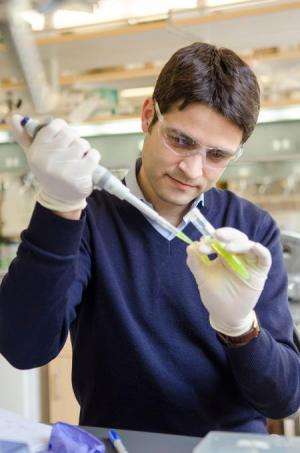Watching the brain do its thing

To a large extent, the brain remains a black box. Taking it out of its case inside the skull and examining it—as in an autopsy—reveals some things, but not how the brain works in a living, functioning being. Assistant Professor of Chemical Engineering Mikhail Shapiro is determined to reveal the mysteries of the brain in situ, in living beings, right down to the cellular level.
Shapiro comes to Caltech from UC Berkeley, where he launched his independent research career as a Miller Fellow. Prior to that, Shapiro was a postdoctoral fellow at the University of Chicago. He received his PhD from the Massachusetts Institute of Technology. Shapiro recently sat down to discuss his research and his adjustment to his new life at Caltech.
What are you most excited about in coming to Caltech?
I'm excited for the opportunity to collaborate with the amazing faculty and students we have here across the disciplines. My first three PhD students all come from different programs, and I already have a collaboration with a colleague in electrical engineering. I can't imagine this happening so quickly and naturally anywhere else in the world.
What is the main focus of your research?
The goal of our research is to develop ways to study biological systems at the cellular level in living, breathing organisms. To do that we need ways to image and control specific molecular functions in tissues noninvasively.
Great advances have been made with dyes and fluorescent proteins to help scientists see what's happening inside living cells, but these techniques don't allow us to penetrate very deeply into larger tissues. So what we want to do is create the equivalents of dyes and fluorescent proteins for technologies like ultrasound and magnetic resonance imaging (MRI) so that we can see and label very specific things deep inside the body, and particularly in the brain.
For example, we are interested in how neural stem cells in the brain—which are regenerated even in adults—develop into different types of brain cells. What kinds of genes do they turn on and off, as they become a neuron or a glial cell in different parts of the brain? We are designing molecular reporters that will allow us to use MRI or ultrasound to monitor these cells as they migrate, express genes, and integrate into functional neural circuits.
How do you get these "molecular reporters" into the body?
The vast majority of the things we're working on are genetically encodable, which means that we can take the relevant genes, put them into a vector—for example, a nontoxic virus—and deliver them to specific cells. So not only would we be able to target a particular region of the brain, but we would be able to target specific cell types.
Will the technologies you're developing be useful in exploring other systems in the body?
Yes. Our main raison d'etre is to develop ways to probe the nervous system, but the technologies we develop could be used in a variety of biological contexts and in synthetic biology. In addition, we are fascinated by the basic science involved with connecting various forms of energy—magnetic fields, sound waves, temperature—with biological molecules and cells. This interface is relatively unexplored, and we hope to contribute to its fundamental understanding.


















